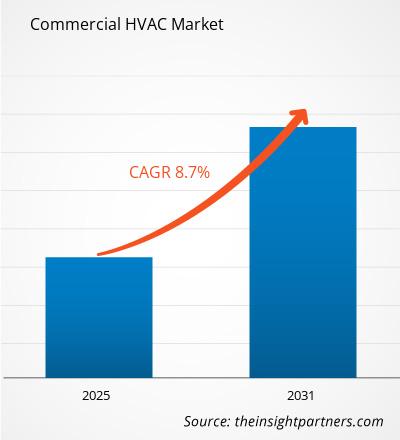商業用 HVAC 市場規模は、2024 年に 793 億米ドルと評価され、2031 年までに 1,364 億 4,000 万米ドルに達すると見込まれています。また、2025 年から 2031 年にかけて 8.2% の CAGR を記録すると予測されています。スマート HVAC システムに対する要件の高まりと、サービスとしての HVAC の需要の増加は、引き続き主要な市場トレンドとなると思われます。
商業用 HVAC 市場分析
商業用 HVAC システムは通常、住宅用のものよりはるかに大規模です。大規模な建物では、適切な暖房、冷房、換気のためにより多くの電力が必要であり、商業ビルは住宅よりはるかに大きいことがよくあります。商業用 HVAC システムは、その規模が大きく、より高い電力要件のため、一般的により複雑です。商業構造における HVAC の要求もより複雑になる可能性があり、建物のさまざまな部分で異なる温度と換気が必要になる場合があります。これにより、ユニット全体を必要に応じて移動または変更して、変化するビジネス条件に対応できます。さらに、大規模ビルの特別な要件に合わせて設計されているため、室内の空気質、エネルギー効率、居住者の快適性が向上します。
商業用 HVAC 市場の概要
世界中で商業建設プロジェクトが増加していることは、商業用 HVAC 市場の成長を促進する主な要因の 1 つです。世界各国で、オフィス建設、空港建設、ショッピングモール建設など、さまざまな商業建設プロジェクトが行われています。たとえば、2024 年第 4 四半期には、N3-5 プロジェクトの建設が開始されました。このプロジェクトでは、日本で 13 階建てのオフィスビルを建設します。このプロジェクトは、2026 年第 4 四半期に完了すると予測されています。さらに、コペルニクスによれば、2024 年は 1850 年まで遡る多くのデータセットにわたる地球の気温記録の中で最も暖かい年でした。したがって、世界的な気温上昇と気象条件により、HVAC システムの需要が高まっています。また、特に冷媒の使用に関して各国政府による厳しい法律や規制が、環境に優しくスマートな HVAC システムの需要を促進しています。
要件に合わせてレポートをカスタマイズ
レポートの一部、国レベルの分析、Excelデータパックなどを含め、スタートアップ&大学向けに特別オファーや割引もご利用いただけます(無償)
商業用HVAC市場: 戦略的洞察

- このレポートの主要な市場動向を入手してください。この無料サンプルには、市場動向から見積もりや予測に至るまでのデータ分析が含まれます。
レポートの一部、国レベルの分析、Excelデータパックなどを含め、スタートアップ&大学向けに特別オファーや割引もご利用いただけます(無償)
商業用HVAC市場: 戦略的洞察

- このレポートの主要な市場動向を入手してください。この無料サンプルには、市場動向から見積もりや予測に至るまでのデータ分析が含まれます。
商業用 HVAC 市場の推進要因と機会
気温の上昇と予測不可能な気象パターン
世界の気温は継続的に上昇しています。コペルニクスによると、2024 年は 1850 年まで遡る多くのデータセットにわたる世界の気温記録の中で最も暖かい年でした。2024 年の世界の平均気温は 15.10 ℃ で、これは 2023 年のこれまでの最高年間記録よりも 0.12 ℃ 高かったことになります。また、2024 年は 1991 年~2020 年の平均よりも 0.72 ℃高く、産業革命以前の水準よりも 1.60 ℃高く、暦年として初めてその水準を 1.5 ℃上回りました。過去10年間は記録上最も暑い年でした。2024年1月から6月までは、各月とも前年の同月よりも暑かったです。2024年8月には気温が2023年8月の記録的な気温に並び、その後の7月から12月まではそれぞれ、この時期としては2023年の同時期に次いで2番目に暑い月となりました。さらに、2024年7月22日には、世界の平均気温が17.16℃という新たな記録を樹立しました。
気候変動の影響で地球の気温が上昇するにつれ、企業の冷房需要も高まっています。この傾向は特に都市部で顕著で、ヒートアイランド現象によって気温上昇が悪化します。商業ビルでは、快適な室内環境を維持するために、より堅牢なHVACシステムが必要とされ、エネルギー効率の高いソリューションの需要が高まっています。リアルタイムの温度データに基づいてパフォーマンスを最適化するスマートHVACソリューションは、エネルギーコストの削減と快適性の向上に重要になっています。したがって、気温の上昇と予測できない気象条件により、商業 HVAC 市場はより現代的で効率的で適応性の高いソリューションの採用を迫られています。ビルの所有者と管理者は、持続可能性と規制基準を満たしながら信頼性の高い快適さを提供できる HVAC システムの必要性をますます認識しています。
新興の改修市場
改修とは、既存の空調システムを更新および変更して、より効率的に動作し、環境への影響を低減するプロセスです。これには、旧式コンポーネントの交換、新しいテクノロジの採用、パフォーマンス向上のためのシステムの最適化が含まれる場合があります。節約率は、コンポーネントの種類など、さまざまな側面によって異なります。米国エネルギー省が実施した調査によると、HVAC システムを改善すると、特に商業ビルでエネルギー費用が 20% ~ 40% 削減される可能性があります。また、いくつかの HVAC 企業は、古いファンを高効率の可変速度バージョンに交換すると、エネルギー費用を 15% ~ 35% 節約できることを示しています。さらに、居住者の存在や使用パターンに基づいて温度を自動調整できるスマートサーモスタットなどの最新の制御システムをアップグレードまたは導入すると、エネルギー消費量を10%~30%削減できると推定されています。米国暖房冷凍空調学会(ASHRAE)によると、ビルディングオートメーションシステムは、HVAC、照明、セキュリティを含むすべてのビルシステムを統合できるため、継続的な監視、リアルタイム診断、システムを調整して効率を最大化できます。さらに、空調ユニット(AHU)を改良または交換すると、特に熱回収技術と高効率フィルターを使用すると、20%~30%の節約になります。
したがって、商業用HVAC業界が進化するにつれて、エネルギー効率の高いソリューションに投資したい企業にとって、改修セグメントは魅力的な機会を提供します。改修を採用することで、企業は規制要件を満たすだけでなく、持続可能性と創造性の文化を育むことができます。この変革は、収益に利益をもたらすだけでなく、より環境に優しく持続可能な未来の創造にも役立ちます。
商業用 HVAC 市場レポートのセグメンテーション分析
商業用 HVAC 市場分析の導出に貢献した主要なセグメントは、機器タイプ、実装、およびアプリケーションです。
- 機器タイプに基づいて、市場は冷却機器、加熱機器、換気機器に細分化されています。冷却機器セグメントは、一体型エアコン、チラー、クーラー、VRF システム、およびその他に細分化されています。加熱機器セグメントは、ボイラー、ヒートポンプ、炉、およびスペースヒーターにさらに細分化されています。換気機器セグメントは、換気機器タイプと換気システムタイプに細分化されています。換気機器タイプセグメントは、空気処理ユニット (AHU)、換気ファン、エアフィルターおよび空気清浄機、ルーフベント、およびその他にさらに細分化されています。また、換気システムタイプセグメントは、制御機械換気 (CMV)、自然換気、およびハイブリッド/混合モード換気にさらに細分化されています。 2024年には、冷却装置セグメントが市場を支配しました。
- 実装に基づいて、市場は新規設置と改修に分割されています。 2024年には、新規設置セグメントが市場を支配しました。
- アプリケーションに基づいて、市場はオフィスビル、ホテルとレストラン、病院と診療所、輸送業界などに分割されています。 2024年には、オフィスビルセグメントが市場を支配しました。
地域別の商業HVAC市場シェア分析
- 商業HVAC市場は、北米、ヨーロッパ、アジア太平洋(APAC)、中東およびアフリカ(MEA)、南米および中米の5つの主要地域に分割されています。 2024年には、北米が商業HVAC市場を支配しました。 アジア太平洋地域は、世界の商業HVAC市場に2番目に大きな貢献者であり、ヨーロッパがそれに続きます。
- 北米の商業HVAC市場は、米国、カナダ、メキシコに分割されています。北米の商業用HVAC市場は、主に商業インフラプロジェクトの増加、急速な都市化、そして高い建設支出によって牽引されています。この地域では、様々な建設プロジェクトが予定されています。例えば、カリフォルニア州(米国)の80.9ヘクタールの土地に複合施設を建設する「リバーウォーク・サンディエゴ」プロジェクトは、2023年第1四半期に着工されました。このプロジェクトは、この地域に優れた商業施設を提供することも目的としており、2029年第3四半期の完成が見込まれています。また、カナダのオンタリオ州トロントでは、3階建てから67階建てまでの29棟の建物を建設する「2150レイクショア複合施設」の建設が2023年第1四半期に着工され、2027年第4四半期の完成が見込まれています。このプロジェクトは、この地域に多様な商業施設や小売施設を、アクセスしやすい形で提供することを目指しています。このように、この地域の建設業界の成長は、HVACシステムの需要を刺激するでしょう。
商業用 HVAC 市場
予測期間を通じて商業用HVAC市場に影響を与える地域的な傾向と要因については、The Insight Partnersのアナリストが詳細に解説しています。このセクションでは、北米、ヨーロッパ、アジア太平洋、中東・アフリカ、中南米における商業用HVAC市場のセグメントと地域についても解説します。
商業用 HVAC 市場レポートの範囲
| レポート属性 | 詳細 |
|---|---|
| の市場規模 2024 | US$ 79.30 Billion |
| 市場規模別 2031 | US$ 136.45 Billion |
| 世界的なCAGR (2025 - 2031) | 8.2% |
| 過去データ | 2021-2023 |
| 予測期間 | 2025-2031 |
| 対象セグメント |
By 設備の種類
|
| 対象地域と国 | 北米
|
| 市場リーダーと主要企業の概要 |
|
商業用 HVAC 市場のプレーヤー密度:ビジネスダイナミクスへの影響を理解する
商業用HVAC市場は、消費者の嗜好の変化、技術の進歩、製品の利点に対する認知度の高まりといった要因により、エンドユーザーの需要が高まり、急速に成長しています。需要の増加に伴い、企業は製品ラインナップの拡充、消費者ニーズへの対応のためのイノベーション、そして新たなトレンドの活用を進めており、これが市場の成長をさらに加速させています。

- 入手 商業用HVAC市場 主要プレーヤーの概要
商業用 HVAC 市場のニュースと最近の動向
商業用 HVAC 市場は、主要な企業出版物、協会データ、データベースなどの一次調査と二次調査を経て、定性的および定量的なデータを収集することで評価されます。商業用 HVAC 市場の動向のいくつかを以下に示します。
- シュナイダーエレクトリックは、2027 年までに米国事業に 7 億ドル以上を投資する計画を発表しました。同社の投資は、AI の成長を促進し、国内製造業を活性化し、エネルギー安全保障を強化するためのエネルギーインフラの強化に重点を置く米国の取り組みを支援するものです。この発表は、データセンター、公共事業、製造業、エネルギーインフラ分野における地域的な需要の高まりを受けて行われました。
(出典:シュナイダーエレクトリック、プレスリリース、2025年3月)
- キャリア・インドは、HVAC(暖房、換気、空調)分野のスキル開発に特化した初のセンター・オブ・エクセレンスを設立しました。キャリアは、熟練したインクルーシブな労働力を育成するというコミットメントに基づき、インテリジェントな気候・エネルギーソリューションに不可欠なSTEM教育と将来を見据えた能力を重視した取り組みを支援しています。この取り組みは、ジャミア・ミリア・イスラミア工科大学(JMI)との共同で、HVAC業界におけるスキルギャップを埋め、学生に知識と実践的な専門知識を提供することを目的としています。
(出典:キャリア、プレスリリース、2025年4月)
商業用HVAC市場レポートの対象範囲と成果物
「商業用HVAC市場規模と予測(2021~2031年)」では、以下の分野を網羅した詳細な市場分析を提供しています。
- 調査対象範囲に含まれるすべての主要市場セグメントについて、世界、地域、国レベルでの商業用HVAC市場規模と予測
- 商業用HVAC市場の動向、推進要因、制約要因、主要な機会などの市場動向
- 詳細なPEST分析とSWOT分析
- 主要な市場動向、世界および地域の枠組み、主要プレーヤー、規制、最近の市場動向を網羅した商業用HVAC市場分析開発
- 市場集中、ヒートマップ分析、主要プレーヤー、商業用 HVAC 市場の最近の動向を網羅した業界の状況と競争分析
- 詳細な企業プロファイル
- 過去2年間の分析、基準年、CAGRによる予測(7年間)
- PEST分析とSWOT分析
- 市場規模価値/数量 - 世界、地域、国
- 業界と競争環境
- Excel データセット
最新レポート
お客様の声
購入理由
- 情報に基づいた意思決定
- 市場動向の理解
- 競合分析
- 顧客インサイト
- 市場予測
- リスク軽減
- 戦略計画
- 投資の正当性
- 新興市場の特定
- マーケティング戦略の強化
- 業務効率の向上
- 規制動向への対応




















 無料サンプルを入手 - 商業用HVAC市場
無料サンプルを入手 - 商業用HVAC市場